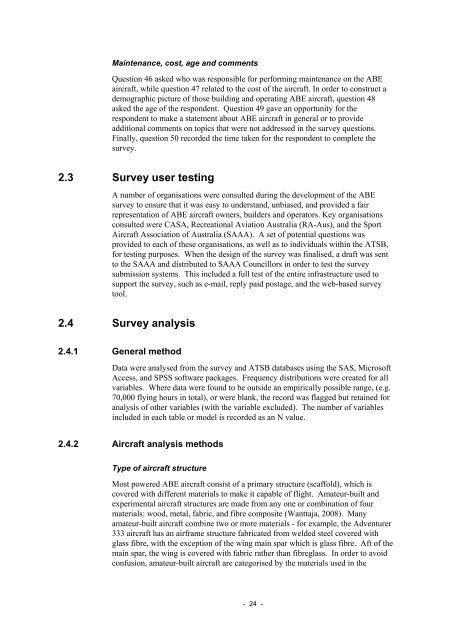Amateur-built and experimental aircraft - Australian Transport Safety ...
Amateur-built and experimental aircraft - Australian Transport Safety ...
Amateur-built and experimental aircraft - Australian Transport Safety ...
You also want an ePaper? Increase the reach of your titles
YUMPU automatically turns print PDFs into web optimized ePapers that Google loves.
Maintenance, cost, age <strong>and</strong> comments<br />
Question 46 asked who was responsible for performing maintenance on the ABE<br />
<strong>aircraft</strong>, while question 47 related to the cost of the <strong>aircraft</strong>. In order to construct a<br />
demographic picture of those building <strong>and</strong> operating ABE <strong>aircraft</strong>, question 48<br />
asked the age of the respondent. Question 49 gave an opportunity for the<br />
respondent to make a statement about ABE <strong>aircraft</strong> in general or to provide<br />
additional comments on topics that were not addressed in the survey questions.<br />
Finally, question 50 recorded the time taken for the respondent to complete the<br />
survey.<br />
2.3 Survey user testing<br />
A number of organisations were consulted during the development of the ABE<br />
survey to ensure that it was easy to underst<strong>and</strong>, unbiased, <strong>and</strong> provided a fair<br />
representation of ABE <strong>aircraft</strong> owners, builders <strong>and</strong> operators. Key organisations<br />
consulted were CASA, Recreational Aviation Australia (RA-Aus), <strong>and</strong> the Sport<br />
Aircraft Association of Australia (SAAA). A set of potential questions was<br />
provided to each of these organisations, as well as to individuals within the ATSB,<br />
for testing purposes. When the design of the survey was finalised, a draft was sent<br />
to the SAAA <strong>and</strong> distributed to SAAA Councillors in order to test the survey<br />
submission systems. This included a full test of the entire infrastructure used to<br />
support the survey, such as e-mail, reply paid postage, <strong>and</strong> the web-based survey<br />
tool.<br />
2.4 Survey analysis<br />
2.4.1 General method<br />
Data were analysed from the survey <strong>and</strong> ATSB databases using the SAS, Microsoft<br />
Access, <strong>and</strong> SPSS software packages. Frequency distributions were created for all<br />
variables. Where data were found to be outside an empirically possible range, (e.g.<br />
70,000 flying hours in total), or were blank, the record was flagged but retained for<br />
analysis of other variables (with the variable excluded). The number of variables<br />
included in each table or model is recorded as an N value.<br />
2.4.2 Aircraft analysis methods<br />
Type of <strong>aircraft</strong> structure<br />
Most powered ABE <strong>aircraft</strong> consist of a primary structure (scaffold), which is<br />
covered with different materials to make it capable of flight. <strong>Amateur</strong>-<strong>built</strong> <strong>and</strong><br />
<strong>experimental</strong> <strong>aircraft</strong> structures are made from any one or combination of four<br />
materials: wood, metal, fabric, <strong>and</strong> fibre composite (Wanttaja, 2008). Many<br />
amateur-<strong>built</strong> <strong>aircraft</strong> combine two or more materials - for example, the Adventurer<br />
333 <strong>aircraft</strong> has an airframe structure fabricated from welded steel covered with<br />
glass fibre, with the exception of the wing main spar which is glass fibre. Aft of the<br />
main spar, the wing is covered with fabric rather than fibreglass. In order to avoid<br />
confusion, amateur-<strong>built</strong> <strong>aircraft</strong> are categorised by the materials used in the<br />
- 24 -

















